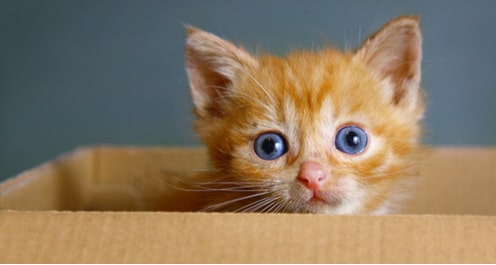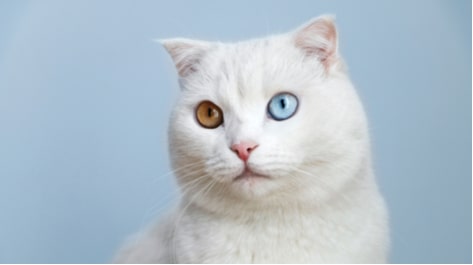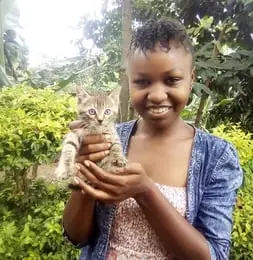What Age Is a Cat That Goes From Blue to Green

The age at which a kitten's color changes:
At 7 weeks, your kitten's adult eye color begins to emerge. They will change from baby blue to the color it will keep permanently.
The eye color will change to yellow, green, orange, or grey. Few cat breeds retain their blue eye color into adulthood. Albino cats' eyes are sensitive to light.
You have just brought your adorable kitty home. As you look into your kitten's eyes, you may notice that it has mesmerizing blue eyes. But later on, as it grows, you will see a color change, and wonder what happened.
I understand as a cat parent, you want to know all about your little one's development. Keep reading to know more about at what age your kitten's color changes, and why it does so.
I will also discuss when color-changing should be a cause of concern, and how to clean your kitten's eyes.
Your Kitten's Eye Color Changes by Week 7
Your kitten is born blind, but its eyes will be mature to open at 2 weeks. However, its eyes are still not fully functional, and objects will appear blurred to it.
For your kitten, its vision ability develops first, then color.
Your kitten develops its full adult eye coloration anywhere from 3 to 6 months of age. Its eyes appear blue.
As your little one develops, its eye color might go through several changes, including brown, gray, green, and orange.
By week 6 or 7, the melanocytes found in your kitten's eyes begin producing melanin, which is the pigment that gives your kitty its mature adult eye coloration. The number of melanocytes and how much melanin they yield, determines the final color and intensity of your kitten's eye.
If your kitten's eye color changes to light green, it means your kitty's iris produced the least amount of melatonin. If your kitten has brown eyes, its iris produced a lot of melanin.
There is a wide array of adult eye colors your kitten can display once they have changed from the baby blue. These include green, blue, yellow, aqua, brown, or copper.
The final eye color of your kitten is determined by genes inherited from its mother and father.
Kittens are Born with Blue Eyes

After your kitten's eye opens, its eyes are blue. The pigment-producing cells in your kitten's eyes produce melanin in response to light.
Since the kitten was in darkness in its mother's womb, its eyes lack melanin and are therefore blue. After their eyes are exposed to light, they will change color.
Different Eye Colors of a Kitten
1. Blue eyes
In rare cases, your kitten might retain its blue eyes into adulthood. This may happen because of low or no melanin production in the iris.
Blue eyes are clear, but the light reflecting around the rounded edges of a cat's pigment-free irises is what makes us see the blue color.
The Siamese cat is an example of a colorpoint cat.
Other breeds that develop with the Siamese as a major genetic contributor also have blue eyes as adult cats. These are:
- Javanese
- Balinese
- Ragdoll
- Birman
- Tonkinese
If blue is your favorite eye color in a cat, and you want your kitten to have this eye color when it grows, go for these above feline breeds, as they will retain their baby blue eye color into adulthood.
However, keep in mind that white cats with two blue eyes have a high tendency of being deaf. A grey cat with blue eyes has a bit of melanin in its fur, but there is completely no melanin on its eyes.
2. Odd eyes

Another unique situation when it comes to cat eye color is odd-eyes which occur in three types:
- Complete heterochromia: This is where one eye is blue, and the other brown or green.
- Sectoral heterochromia: You can see two eye colors are present in the iris.
- Central heterochromia: Two colors can be seen on the iris, a central color that surrounds the pupil and a different color on the outside portion of the iris.
3. Copper or yellow eyes
Most people assume their cat's eye color is brown when it is actually dark copper, or dark orange.
Regardless of the amount of melanin produced on your cat's iris, the darkest eye color it can get is dark copper.
There is no cat with black eyes.
4. Green eyes
If your kitty has green eyes, it means that its iris produced very little melanin. You can find a white cat with green eyes or a black cat with green eyes. This is because genes control the amount of melanin in your cat's fur.
There is no relation between fur color and eye color in your cat.
If you like your kittens to have green eyes, go for breeds such as the Chinchilla Persian, or the Russian Blue, which has mesmerizing emerald green eyes that contrast with its slate-grey fur.
5. Yellow or orange
Your kitten's eye color may change to yellow or orange, but the level of activity of melanocytes will determine the color's intensity.
That means your cat with orange eyes might have a stronger gaze, than your neighbor's cat with the same orange eyes.
Yellow and amber eyes are common in cats, and we must admit that these furry felines have a stunning glowing glare.
Aqua is a rare kitten eye color which has a green-blue hue. It occurs in the Tonkinese and Bengal breeds.
Eye Color Change in an Adult Cat Indicates Sickness
Once your kitten has changed its eye color, this should remain consistent throughout its life. If you observe any change in eye color in your adult cat, it could be an indication of a health problem.
If your cat's eyes look red and swollen, it could be an inflammation of the light pink lining around your cat's eyes, which is conjunctivitis. Contact your vet immediately to know how to help your cat.
How to Tell if Your Kitten is Albino
It is quite difficult to tell the difference between an albino cat, and a blue-eyed white cat. At this point, let me clarify that not all white cats have albinism.
Albinism is very rare in the cat family, with only 2% of all cats being albino. Here is how to tell an albino cat apart from a white cat.
An albino cat has pink skin, and its eye color will be either light blue or with a hue of reddish-pink. The pink color you see is light reflecting blood flow.
The same concept applies to albino cat's eyes. The reddish-pink color you see is a reflection of light that mirrors back on the blood vessels of its eyes. The iris lacks melanin, and therefore there is no pigmentation.
An albino kitty does not have the melanin to produce a range of eye colors such as brown, green, or gold. White cats can have a variety of eye colors, including two different-colored eyes.
In summary, here are quick facts about albino cats:
- They are light-sensitive: The lack of melanin makes an albino kitty sensitive to sunlight. If your kitten is albino, limit its exposure to the sun, as it could get skin cancer and sun damage.
- They can suffer eye damage in sunlight: Your albino kitten can suffer eye damage because the lack of melanin in its eyes makes it more vulnerable to UV sunlight rays damage, which can cause blindness.
- Albino cats are more likely to suffer from immune system issues: Melanin is vital to keep a cat's immune system strong. The lack of it makes an albino cat more susceptible to illness.
Common Kitten Eye Problems
It is fairly common for kittens to develop an eye problem.
It could be an allergy or eye infection that is causing your kitten to have watery eyes. Your kitten is active, and it may accidentally hurt its eyes while playing.
Signs of an eye injury in your kitten are:
- Discharge from one or both eyes.
- Lumps or bumps around the eyes.
- Squinting.
An eye injury can also result in a scratch from its littermates. Congenital problems are common with Persian kitties. This is because this breed has short flat faces with large eyes.
This unusual face structure predisposes Persian kittens to eye tearing, and improper eye drainage.
If you have a Persian kitten, it is important to take your little one to the vet for regular eye checkups. Your vet will examine it for signs of eye infections, or any other underlying medical problem.
How to Clean Your Persian Kitten's Eyes
A Persian kitten's eyes often have underdeveloped tear ducts. Therefore this leads to frequent eye drainage. The excess tears fill over,drip on its face, and when they dry, they leave an unattractive under-eye straining.
If your kitten is a Persian breed, cleaning your little one's eyes will become a routine for you and your pet. Its eyes are prone to debris build-up if left unmanaged.
Here is what you will need to start the cleaning process:
- Warm water.
- Cotton pads.
- A small bowl.
Remember your kitten might not like this routine at first, but be patient with it. Once you incorporate this cleaning process into a routine, your little one will get used to it, and even enjoy it.
The process:
- Wash your hands thoroughly.
- Pour the warm water into a bowl. Dampen the cotton wool on the warm water, and gently wipe under one eye with the damp cotton wool. Ensure you don't touch your kitten's eye as it might irritate your kitty, and make it resist future cleanings.
- Use a new damp cotton pad for the next eye to avoid spreading germs between each eye.
- Repeat the process daily to ensure your Persian kitten's eyes stay clean.
Writer: Flora Ojow

Read about me
Sources
http://www.kittenlady.org/age
https://www.catster.com/kittens/when-do-kittens-eyes-change-color
https://pets.webmd.com/cats/eye-discharge-in-cats#1
https://www.quora.com/What-determines-a-kittens-eye-color
https://persiancatcorner.com/clean-persian-cats-eyes/
https://www.thehappycatsite.com/cat-eye-colors/
Source: https://archiecat.com/at-what-age-can-you-tell-a-kittens-eye-color/
0 Response to "What Age Is a Cat That Goes From Blue to Green"
Post a Comment